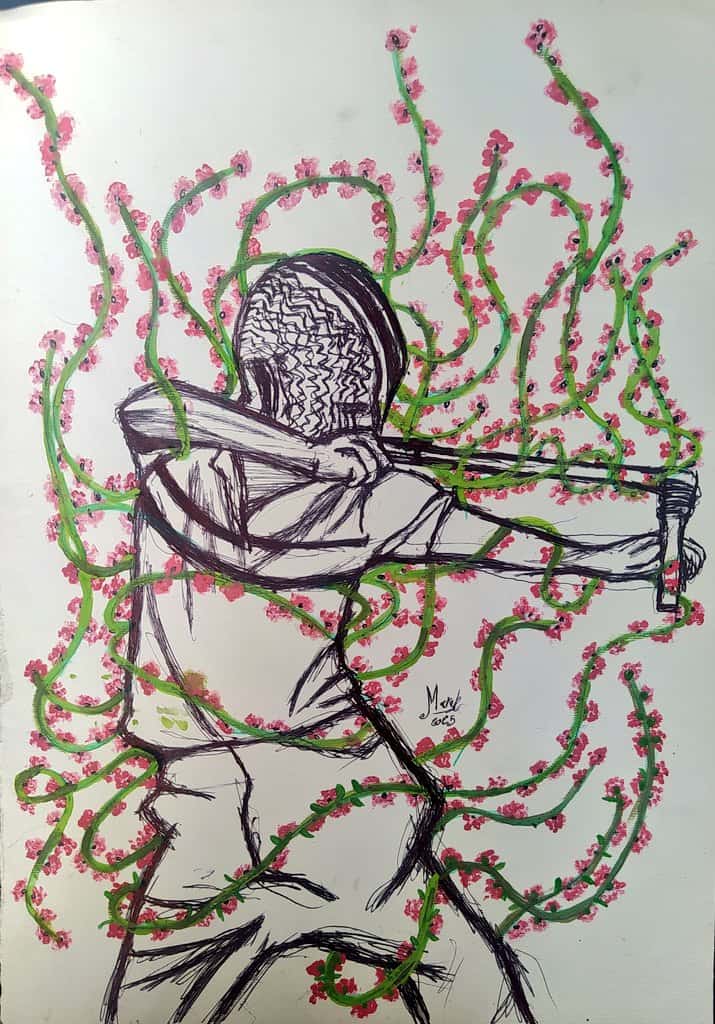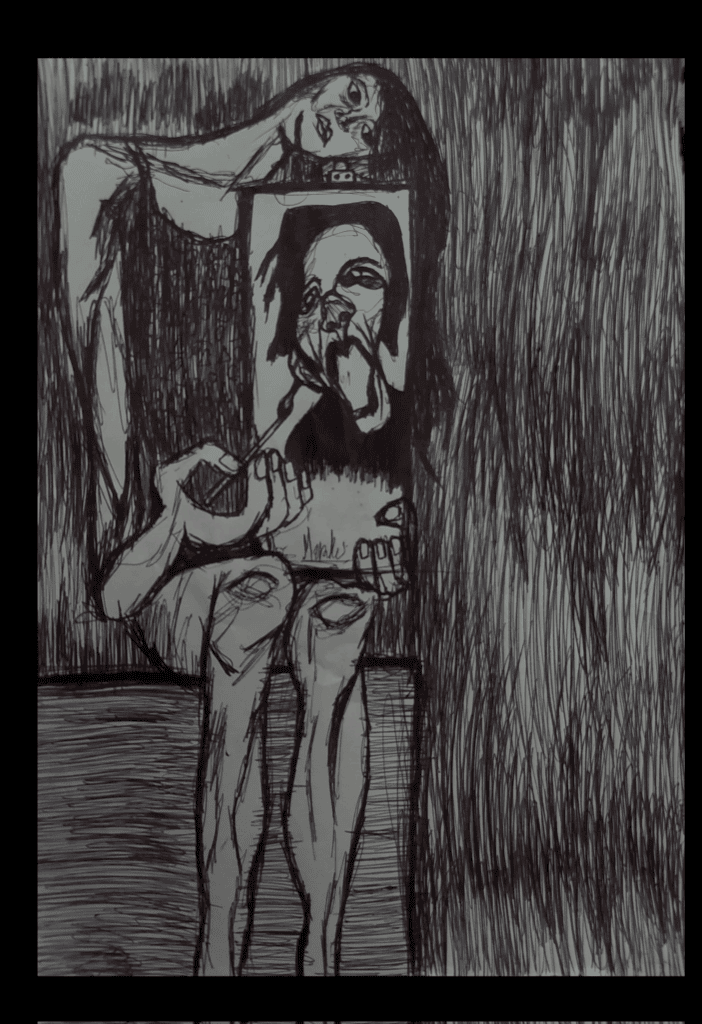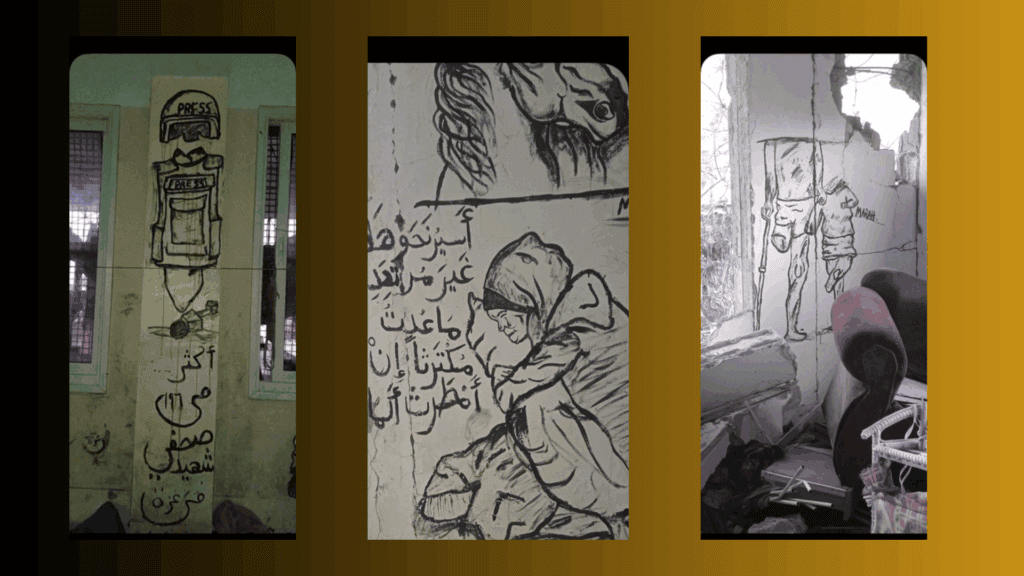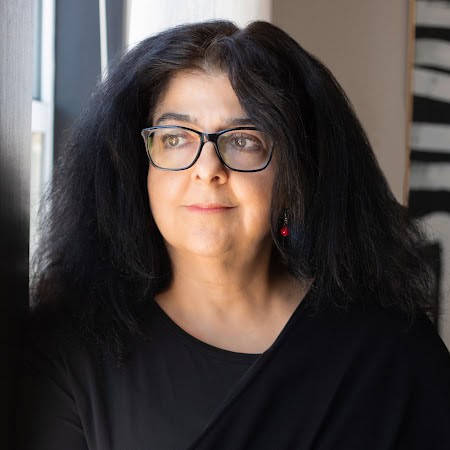Marah Khalad is an artist in Gaza whose powerful, expressive work conveys her response to the ongoing genocide. Her drawings and paintings reflect real events she has witnessed and experienced, while also capturing the psychological toll of living through trauma. I reached out to her to learn more about how her experiences and perspectives influence her artistic style and her creative process.

LAG: Marah, your art is very powerful. Thank you for being willing to share your thoughts about your work. I love the cover image I’m using for this interview article where a person with a slingshot is surrounded by a flowering vine. Can you tell me more about it?

MK: Its title is “Flowers in the Face of Bullets.” Here, the slingshot is a symbol of popular resistance it represents that we are an unarmed people who have no tanks or weapons. The keffiyeh symbolizes Palestine. The flower stems wrapping around him represent hope and life amidst violence and destruction. Even in the moment of resistance and confrontation, there is still something pure and alive within us.
The message I want to convey through this drawing is that resistance is not only an act of violence, but also a form of holding on to life, dignity, and rights. The flowers represent freedom. They fight alongside us. We do not defend our land out of hatred, but from a deep love for life on our land, which is rightfully ours.

LAG: When did you begin to take an interest in art? Did you take art classes in school?
MK: I didn’t used to paint much before the war because I was busy with studying and normal daily life. But when the war began, my life was turned upside down. Everything changed suddenly — emotions were all mixed: fear, sadness, anger. I lost my friends and loved ones, and there was a deep anger inside me that I couldn’t release except through painting. I painted my emotions, the scenes I witnessed, and the pain I’m living through… I never joined any art classes or took any drawing courses.
LAG: How do you describe your style of art? What do you want to communicate with your art?
MK: My artistic style is “Realistic” because I mostly paint what I see, and “Expressive” because I express my emotions. I want to convey the pain we have lived and are still living — the fear, loss, and deprivation — because we don’t deserve to endure all of this. We deserve life.

LAG: I notice there is a “dream” element, or maybe “nightmare” element, in some of your work where the image is not completely realistic. Do you find those paintings express your feelings more accurately?
MK: Yes, indeed, there are some paintings that are not realistic, like “Cry of the Soul” and “The Pain of Silence.” I’m a sensitive and gentle person who can’t express herself through writing or by screaming out loud — so I scream through my paintings. That’s why most of my artworks contain some form of screaming; it comes from deep inside me and expresses my emotions.

MK: I drew the artwork (“The Cry of the Soul”) at the beginning of the famine, when we couldn’t find anything to buy. I had gone several days without food when I created it. I drew it while silently screaming to the whole world about what was happening. My emotions and thoughts turned into spirits or ghosts screaming with me. My hand was trembling with rage and pain as I drew.


LAG: Can you tell me more about the painting titled “Conflict Between Reality and the Self”?
MK: It expresses the intense conflict between myself and the reality I live in. I try to understand my identity or make sense of the immense pain I carry. The tilted head and distorted features reflect the psychological exhaustion and pain I experience. My hand, painting the image, is an attempt to confront or understand this pain, while the dark background intensifies the feeling of suffocation and loss.


LAG: You have a pen and ink drawing that depicts a wounded woman standing in a swirl. Can you explain this and other details of the painting?
MK: The dense black liquid flowing from these holes, which suggest spiritual wounds and invisible scars, melts into the intertwined circles on the ground as if the pain is pouring out endlessly from within. The circles represent the extent and spread of this pain, just like an unceasing waterfall whose echoes resonate in all directions.


LAG: I notice that on social media, you have posted images that are painted on walls. How often do you have an opportunity to paint these larger works?
MK: I don’t paint on walls very often because I don’t have the right colors. However, I painted all the classroom and school walls at the school I was displaced to about six months ago in Deir al-Balah. But after the evacuation warning, we left, and I couldn’t find the paints I had bought.



LAG: Marah, thank you for sharing your artist statements. Do you have any closing thoughts for Baladi Magazine’s readers?
MK: Art is my window to life and my tool of resistance. With my brush, I narrate our stories, and with my colors, I plant hope in a homeland where hope has died. Painting is not just a talent it is my language: the voice through which I cry out the suffering and dreams of my people. I still believe that art can touch your hearts and deliver messages that words cannot. Because art is a voice that cannot be silenced.

To view more of Marah Khaled’s art, follow her on X and Instagram. You may donate to support Marah and her family at https://chuffed.org/project/140616-give-the-young-artist-marah-khaled-a-chance-to-survive.

